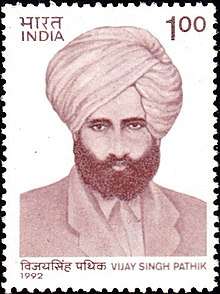Vijay Singh Pathik
Vijay Singh Pathik alias Bhoop Singh Gurjar (1882–1954), popularly known as Rashtriya Pathik,[1] was Indian revolutionary. He was among the first Indian revolutionaries who lit the torch of freedom movement against British rule. Much before Mohandas K. Gandhi initiated the Satyagrah movement, Pathik experimented during the Bijolia’s Kisan agitation. His real name was Bhoop Singh Gurjar[2], but after being implicated in the Lahore conspiracy case in 1915, he changed his name to Vijay Singh Pathik. His grandfather's sacrifice in the struggle of 1857 in Bulandshahr district, affected him deeply to be freedom fighter and rovolutionis. His descendants now live in Delhi.
Vijay Singh Pathik | |
|---|---|
 Vijay Singh Pathik on a 1992 stamp of India | |
| Born | |
| Nationality | Indian |
| Other names | Bhoop Singh Gurjar, Rashtriya Pathik |
| Parent(s) | Kamal Kunwari (Mother) Hamir Singh Gurjar(Father) |
Early life
Vijay Singh Pathik was born in 1882 in Guthawali village of Bulandshahar district to Hamir Singh and Kamal Kunwari in a Gurjar family .[3][4][5] His father Hamir singh took active part in the Sepoy Mutiny of 1857 and got arrested many times. The name of his grand father was Inder Singh, who was Prime Minister (Diwan) of Malagarh principality (Riyasat) who was killed while fighting against the British. His birth name was Bhup singh, but he changed it to "Vijay Singh Pathik" after being implicated in the Lahore Conspiracy Case in 1915.[4]
Bijoliya Kisaan Andolan
He joined revolutionary organisation in his teenage and took active part against British rule in India. Pathikji’s non-cooperation movement was so successful that Lokmanya Tilak wrote a letter to Maharana Fateh Singh to meet the demand of the Bijoliya agitators. Mahatma Gandhi sent his secretary Mahadev Desai to study the movement. It was Pathikji who fought for the cause of united Rajasthan and had taken up the issue with Prime Minister Jawaharlal Nehru and Sardar Patel. He was jailed for having led the Kisan agitation in Bijoliya and kept at special jail created in the Tehsil building of Todgarh. The Kisan Panchayat, Mahila Mandal and Yuvak Mandal invited Pathik to come and lead them. Women of Mewar started to get respect from their folk men. Pathik made people feel that women and men equality is necessary to develop a prosperous society.
Pathik was a great patriot and freedom fighter. As author Indira Vyas said, "He would prefer to end his life rather than to bow down the flag. He also wrote the famous flag song which was very popular during that period."[6]
Writer and poet
Being Indian Revolutionary and Satyagrahi, he was also a very well known Hindi poet, writer and journalist. He was the editor of Rajasthan Kesari and Naveen Rajasthan. He also started his own independent Hindi weekly, the Rajasthan Sandesh and the Nav Sandesh from Ajmer.
He expressed his views through Tarun Rajasthan, Hindi weekly too. He popularly had known as Rashtriya Pathik.
As writer also he made impact through some of his well-known books -Ajay Meru ( novel), Pathik Pramod (collection of stories), Pathikji ke Jail ke Patra, Pathik ki Kavitaon Ka Sangrah etc.[1] He was also appointed as the President of the Rajputana and Madhya Bharat Provincial Congress.
Even Rastrapita Mahatma Gandhi said about him Pathik is a worker, others are talkers. Pathik is a soldier, brave and impetuous...
The Government of India issued a postage stamp to pay tribute to him.[7]
Pathikji died in Ajmer in 1954, when Rajasthan state is formed.
The Vijay Singh Pathik Smriti Sansthan chronicles the contributions of Pathikji.[8]
References
- Durga Das Pvt. Ltd (1985). Eminent Indians who was who, 1900–1980, also annual diary of events. Durga Das Pvt. Ltd. p. 238.
- David Hardiman (25 October 2018). The Non Violent Struggle for Freedom 1905-1919. Penguin Random House India Private Limited. pp. 180–. ISBN 978-93-5305-262-1.
- Shodhak. Bhartiya Pragtisheel Shiksha Parishad. 1986.
- Sushma Suresh, ed. (1999). Who's who on Indian stamps. Mohan B. Daryanani. p. 288. ISBN 978-84-931101-0-9.
- Bhartiya Pragtisheel Shiksha Parishad (1986). Shodhak, Issues 43-45. Bhartiya Pragtisheel Shiksha Parishad. p. 49.
- Indira Vyas (2004). Freedom movement in Rajasthan: with special reference to Ajmer-Merwara. University Book House. p. 81. ISBN 81-8198-011-5.
- Who's who on Indian stamps. Mohan B. Daryanani. 1999. p. xvi. ISBN 84-931101-0-8.
- "Vijay singh Pathik smarika". times of India.